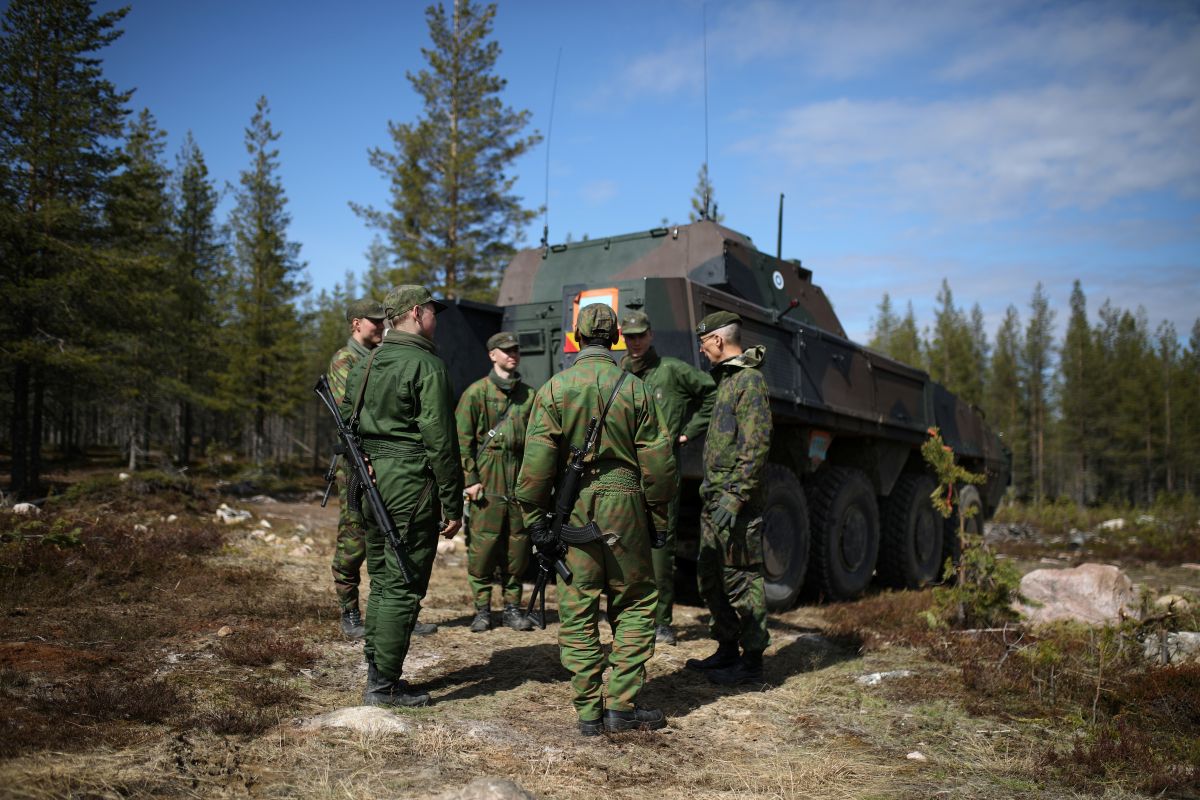The Impact of Finland's and Sweden's Accession to NATO on the Security of the Alliance
The accession of Finland and Sweden to NATO will increase the Alliance’s ability to conduct collective defence missions in the Baltic Sea region and to deter Russia. Therefore, the gains from the enlargement of the Alliance will far exceed the costs, which may include the need to create a new command responsible for missions on the Northern Flank of NATO. However, Türkiye’s opposition may prolong the accession process and increase the risk associated with the intensification of Russia’s provocative actions against the candidates.
 STOYAN NENOV / Reuters/ FORUM
STOYAN NENOV / Reuters/ FORUM
On 18 May, Finland and Sweden formally applied for NATO membership. Most allies would like the accession procedure to be completed as soon as possible due to threats and provocative actions by Russia. However, Türkiye (formerly Turkey) threatened to veto accession if both countries did not change their policies towards Kurdish organisations. Türkiye also expects the sanctions on arms exports imposed after the Turkish intervention in Syria in 2019 to be lifted.
Change of Attitude Towards NATO Membership
The Russian military invasion of Ukraine in 2022, preceded by an ultimatum to NATO that included the suspension of the Alliance’s enlargement policy, led to a radical change in Finland’s and Sweden’s threat perception. After the end of the Cold War, both countries gave up their traditional neutrality by joining the European Union, but decided to continue policies of non-alignment, remaining outside military blocs. At the same time, they reserved the right to join NATO, emphasising their sovereignty, lack of acceptance of spheres of influence, and additional opportunities to resist possible political and military pressure from Russia. They also noted that the security of the two countries was closely related and that they would make a joint decision about joining NATO. However, until this year, the stance on membership was primarily determined by the low support for NATO amongst the public, which in Finland amounted to around 25% and in Sweden about 35%. Since the Russian aggression against Georgia in 2008, Sweden and Finland have worked to strengthen their security, including by building closer relations with NATO and the main members of the alliance, especially the U.S. and the UK. The full-scale Russian military invasion of Ukraine altered the status quo drastically and increased the risk of a direct confrontation with NATO and the EU, which changed the states’ strategic calculations. Due to the commonality of interests with NATO and EU members, and numerous legal and international obligations (including EU security guarantees), both countries would be under pressure to provide support to attacked partners. At the same time, they would be exposed to the threat of Russian attack and nuclear blackmail without credible security guarantees. The decision to join NATO was also influenced by the radical change in public support for membership, which after the Russian invasion of Ukraine on 24 February increased in weeks in Sweden to 56% and in Finland up to 76%.
Costs and Benefits of NATO Membership
The accession of Finland and Sweden to the Alliance will strengthen NATO’s ability to conduct collective defence missions in the Baltic Sea region. Both countries, in accordance with the Alliance’s requirements, are able to ensure the ability to defend themselves and support joint missions in proportion to their potential. Finland, with a population of 5 million and a 1,340-km long border with Russia has 900,000 trained citizens in reserves and could mobilise 280,000 soldiers during wartime. Sweden, with a population of 10 million, does not border Russia and has much smaller land forces, which are, however, prepared to defend Gotland, an island in the Baltic Sea that is strategically important for the control of the airspace and sea lanes in the region. For years, both countries have been preparing to jointly defend the strategically located Åland Islands. Sweden and Finland belong to an exclusive group of NATO privileged partners (Enhanced Opportunity Partners), which has prepared them to conduct the most demanding missions with the Alliance. Their troops are already part of NATO multinational forces (NATO Response Force, or NRF), which can be deployed for collective defence or out-of-area missions. After joining NATO, Sweden and Finland should strengthen the additional forces developed by the allies as reinforcements (NATO Readiness Initiative, or NRI) and multinational units stationing on the Eastern Flank. The air forces of both countries (especially the F-35 planes purchased by Finland) and air and missile defence systems (including Patriot systems purchased by Sweden) will increase NATO’s ability to achieve air superiority, which is necessary to conduct collective defence missions. The navies (especially Swedish submarines and corvettes) will strengthen the capacity of the Alliance’s naval forces necessary to protect the Baltic and North Atlantic sea lanes, which are crucial for the U.S. ability to send reinforcements to Europe. They will enhance the Alliance’s intelligence and cyberdefence capabilities and bring in the “total defence” experience. Thanks to their geographical location, Sweden and Finland will provide additional air and sea access to the Baltic States, contributing to their defence. NATO’s ability to operate in the Arctic, where Russia is developing its military infrastructure, also will be strengthened. However, to use the potential of both countries, it may be necessary to expand the Alliance’s command structure and establish a command for operations on the Northern Flank.
For historical and political reasons, neither country will seek a permanent presence of NATO troops on their territory, but will rely instead on reinforcements in times of crisis. They also will be cautious in demonstrating support for NATO’s nuclear deterrence. Even if after accession they declare that they did not intend to deploy nuclear weapons or host permanent NATO bases on their territory, this should not undermine the credibility of Alliance deterrence policy.
Russian Threats
Russia has warned that NATO enlargement would lead to a deterioration in security in the Baltic Sea region and threatened to deploy nuclear weapons near the borders with the Alliance. However, Russian dual-use systems capable of carrying conventional and nuclear warheads have already been present in Kaliningrad, around Saint Petersburg, and elsewhere in the area. Russia also conducts regular exercises during which it concentrates large numbers of troops near NATO’s borders and simulates attacks on different countries, including Sweden and Finland. Russia’s announced reaction should therefore not be viewed as a new threat in the Baltic Sea region. However, new threats to the candidate countries may arise over the intensification of aggressive actions by Russia in response to their decision. There has been an increase in cyberattacks against Sweden and Finland in recent weeks. The Russian military has also violated Finland’s airspace. Some allies, including the U.S., United Kingdom, Germany, and Poland, announced that in the event of Russian aggression they would provide military support to both candidates before they were formally covered by the security guarantees under Art. 5. The declarations were strengthened by a defence agreement between the UK, Sweden, and Finland. Exercises by the British-led multinational Joint Expeditionary Force (JEF) and annual BALTOPS manoeuvres in the Baltic Sea were organised to demonstrate Allies’ readiness to defend both candidates.
Conclusions and Perspectives
The decision on Sweden and Finland to join NATO reflects a radical change in the European security system brought about by the Russian full-scale invasion of Ukraine. Membership of these countries in the Alliance will increase NATO’s potential, in particular its ability to conduct the collective defence mission in the Baltic Sea region and on NATO’s Northern Flank. As a result, NATO’s ability to deter Russia will increase. Increasing the potential of the European part of NATO will have a positive impact on the distribution of costs between the U.S. and Europe related to maintaining common security. It also will be easier to develop the EU’s security policy in such a way as to complement NATO’s potential, rather than compete with it. As Sweden and Finland meet all Alliance standards, the conclusion of the accession process depends mainly on the speed at which the member states ratify the protocols to the North Atlantic Treaty. However, Türkiye’s announcement that it will not support membership until its demands are met may extend the process. While the political problems are most likely to be resolved, prolonging the accession process will create additional risks for the candidate countries and for NATO. Türkiye’s attitude will alter its perceptions and harm its credibility with many member states.


